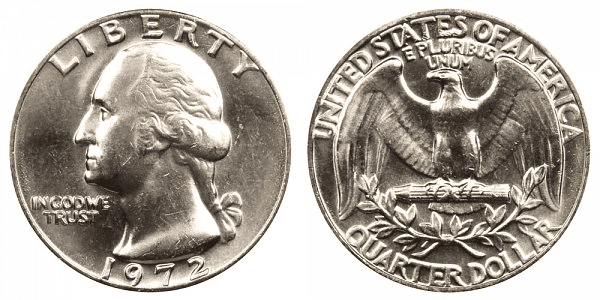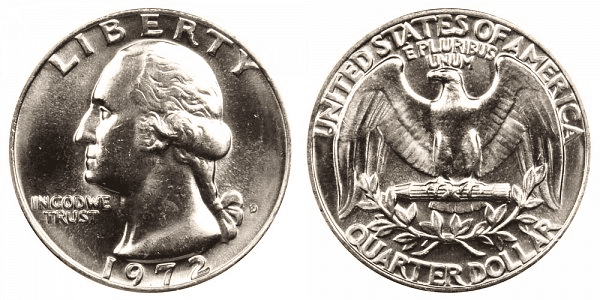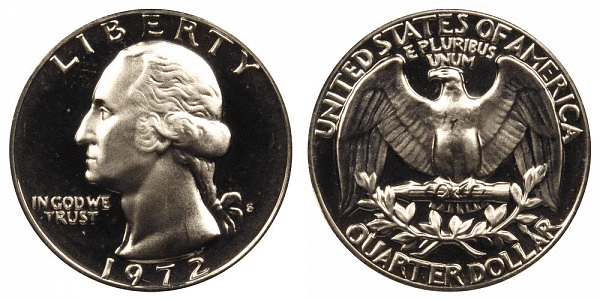Is A 1972 Quarter Made Of Silver?
While earlier examples of Washington Quarters have a silver content, from 1968 onwards, quarters featured a 25% Nickel cladding with a 75% Copper center. The left-facing depiction of George Washington featured on the coin’s obverse, created by John Flanagan, is based on the 1786 bust by Jean-Antoine Houdon.
Above Washington’s hair and around the top of the coin is LIBERTY. Below the truncated bust of George Washington, the year “1972” is engraved around the bottom. The country’s motto, IN GOD WE TRUST, is displayed to the left of Washington.
A sheaf of arrows is supported by an Art Deco-style heraldic eagle is seen on the reverse side of the coin. The eagle’s head is pointing left, as are the arrows. The bottom of the eagle is surrounded by a U-shaped arrangement of two sprays of olive branches.
The words the UNITED STATES OF AMERICA are written around the top of the coin. The motto E PLURIBUS UNUM appears below it. The word “QUARTER DOLLAR” is written around the perimeter of the coin’s base. The 1972 Washington quarter has a reeded edge.
The Watergate scandal began in 1972, the same year that NASA’s space program was formally introduced. The year’s largest box office smash was The Godfather, while Don McLean’s American Pie topped the charts.
1972 Quarter Varieties
1972 Quarter With No Mint Mark
Year: 1972
Face Value: $0.25
Composition: 75% copper, 25% nickel
Total Weight: 5.67g
Diameter: 24.3 mm
Thickness: 1.95 mm
Edge: Reeded
Minted in: Philadelphia
Quantity Minted: 215,048,000

photo source: www.usacoinbook.com
1972 D Quarter
Year: 1972
Face Value: $0.25
Composition: 75% copper, 25% nickel
Total Weight: 5.67g
Diameter: 24.3 mm
Thickness: 1.95 mm
Edge: Reeded
Minted in: Denver
Quantity Minted: 311,067,732

photo source: www.usacoinbook.com
1972 S Quarter
Year: 1972
Face Value: $0.25
Composition: 75% copper, 25% nickel
Total Weight: 5.67g
Diameter: 24.3 mm
Thickness: 1.95 mm
Edge: Reeded
Minted in: San Francisco
Quantity Minted: 3,260,996

photo source: www.usacoinbook.com
It’s worth noting that 1972 S Washington Quarters were struck only as Proof coins.
List of errors
There are a few minor errors sometimes seen on 1972 quarters. The most frequent error on the 1972 quarter, according to our analysis, is the presence of a second seven directly between the 7 and the 2 digits. The circle on the coin’s face that connects on the back is another mistake.
However, these errors are minor and commonplace and do not tend to impact the value of the coin particularly.
How Much Is A 1972 Quarter Worth Today?
As it contains no precious metal, the melt value of a 1972 Quarter is a paltry $0.052, meaning that any value (outside of the face value) seen in this coin comes from factors such as condition, errors, and provenance. As these coins are still in circulation, the main value outside of rarities comes from its condition with all but MS grade coins being worth their face value and no more.
For example, A 1972 P Washington Quarter in mint condition is worth between.25 and.50 cents if worn and used.
However, the value may range from $1 to $2 if they grade MS63. If graded and confirmed MS67 in PCGS or NGC holders, a raw or ungraded uncirculated sample of a 1972 P Washington quarter in exceptional condition can be valued at up to $700.
How Does The Grading System Work?
The Sheldon Scale is used by numismatists to provide a numerical value to coins. The Sheldon Scale goes from poor (P-1) to perfect mint state (P-1) (MS-70). Coins were originally evaluated using words to reflect their condition (Good, Fair, Excellent, Etc.). Unfortunately, coin collectors and dealers had different ideas about what each of these terms represent.
Professional numismatists joined together in the 1970s and established CoinGrading standards. These numismatists now assign grades at key places on the seventy-point scale, using the most regularly utilized numeric points in conjunction with the original adjective grade. The following are the most common coin grades:
-
-
- (P-1) Poor – Indistinguishable and probably damaged; if used, must have a date and mintmark; otherwise, rather battered.
- (FR-2) Fair – Nearly smooth, but without the damage that a coin graded Poor often possesses. The coin must have enough detail to be identified.
- (G-4) Fair – Inscriptions have merged into the rims in some areas, and important elements have been mostly erased.
- (VG-8) Very Good- A little weathered, but all of the primary design elements are visible, albeit faintly. There is little if any, central detail left.
- (F-12) Good – The item is very worn, yet the wear is even, and the overall design details stand out clearly. Rims are almost completely isolated from the field.
- (VF-20) Very Fine – Moderately weathered, with some finer features still visible. The motto or all letters of LIBERTY are readable. Both sides of the coin have entire rims that are separated from the field.
- (EF-40) Extremely Fine – Gently used; all gadgets are visible, and the most important ones are bold. The finer details are bold and clear, however, light wear may be seen.
- (AU-50) Uncirculated – Slight evidence of wear on the coin’s design’s high points; may have contact marks; eye appeal should be adequate.
- (AU-58) Uncirculated Choice – Slight traces of wear, no severe contact marks, almost full mint shine, and great eye appeal.
- (MS-60) Mint State Basal – Strictly uncirculated; no indication of wear on the coin’s highest points, but an unsightly coin with reduced luster, visible contact marks, hairlines, and other flaws.
- (MS-63) Mint State Acceptable – Uncirculated, but with contact scratches and nicks, little reduced shine, but otherwise appealing appearance. The strike is weak to average.
- (MS-65) Mint State Choice – Uncirculated with great mint shine, very little contact blemishes, and exceptional eye appeal. The strike is unusually severe.
- (MS-68) Mint State Premium Quality – Uncirculated with superb luster, no obvious contact marks to the naked eye, and exceptional eye appeal. The strike is quick and appealing.
- (MS-69) Almost Perfect Mint State – Uncirculated with perfect brilliance, a sharp and appealing strike, and extremely good eye appeal. A near-perfect coin with minor imperfections in the planchet, strike, and contact markings (seen only under 8x magnification).
- (MS-70) Mint State Perfect – Under 8x magnification, there are no tiny imperfections discernible; the strike is crisp, and the coin is perfectly centered on a beautiful planchet. Rarely seen on a coin, this coin is bright and whole, with original luster and exceptional eye appeal.
-
Where To Buy Or Sell 1972 Quarters?
1972 nickels aren’t very sought after because of their low worth unless they have a special feature, like a mistake. As a result, you can still find 1972 Nickels in your change or buy one online for a dollar or two, albeit there isn’t much money to be made from buying or selling these coins aside from sentimental value.
Nickels from 1972 that are an exception and those with errors might have values that reach thousands of dollars.
While certain examples can be found on websites like eBay or Etsy, it is more advised to deal with reputable coin dealers and auction houses like Heritage Auctions for more peace of mind.
FAQs
How do you know if your quarters are valuable?
The first step to assessing the value of your quarter is to look at the date. Quarters produced before 1968 have a composition of 90% Silver and 10% Copper, meaning their melt value is far higher than those produced in later years. Regardless of the date, you’ll also want to inspect the overall condition of the coin, checking for details that have been worn away, and any errors in the strike.
Do 1972 quarters have mint marks? / Where is the mint mark on a 1972 quarter?
Yes, all 1972 Quarters produced outside of Philadelphia (who never mint mark their coins) will have a mint mark. You can see ‘D’ for Denver, and ‘S’ for San Francisco to the right of the motto ‘In God We Trust’ on the obverse side of the coin.
Are there any rare 1972 quarters?
1972 wasn’t a particularly good year for rare coins, partially due to the relatively recent changes in metal composition and the reliable striking of coins. There are still some special error coins out there, such as clipped planchets and so on, but these are seen on a coin-by-coin basis.
What quarters are worth keeping?
Due to their silver content, quarters before 1968 can be worth holding on to and some people prefer keeping coins with silver content as part of a nest egg, with the hope of selling them when the value of silver increases.



